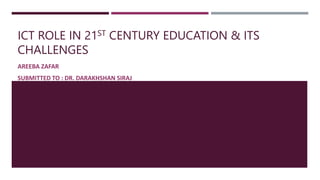
ICT Role in 21st Century Education & its Challenges.pptx
- 1. ICT ROLE IN 21ST CENTURY EDUCATION & ITS CHALLENGES AREEBA ZAFAR SUBMITTED TO : DR. DARAKHSHAN SIRAJ
- 2. INTRODUCTION Information and Communication Technology (ICT) has revolutionized education in the 21st century. Offering innovative tools platforms to enhance learning experiences. In this presentation, we will explore the pivotal role of ICT in modern education and the challenges it brings forth.
- 3. ICT IN EDUCATION AND ITS IMPORTANCE ICT in education refers to the integration of technology tools and resources to enhance teaching and learning experiences. Importance of ICT in Education: ICT provides opportunities for: personalized learning access to vast resources collaboration among students and educators prepares learners for the digital world empowers students to engage with content in dynamic ways, fostering critical thinking, creativity, and problem-solving skills.
- 4. BENEFITS OF ICT IN LEARNING Personalized learning Access to information Collaboration Digital literacy
- 5. EXAMPLES OF ICT TOOLS USED IN EDUCATION: Smartboards: Interactive whiteboards that allow real-time interaction with digital content. Educational apps: Mobile applications designed to support learning in various subjects and skills. Online platforms: Learning management systems, virtual classrooms, and educational websites providing access to online courses, resources, and interactive activities.
- 6. CHALLENGES FACED IN ICT-BASED EDUCATION 1. Digital Divide The digital divide refers to the gap between those who have access to modern information and communication technologies (ICT) and those who do not, often based on socioeconomic factors. Impact of the Digital Divide on Education Outcomes: Limited access to technology and the internet can hinder students' ability to engage in digital learning opportunities, leading to disparities in educational outcomes based on socioeconomic status.
- 7. CHALLENGES (CONT.) 2. Infrastructure and Connectivity Reliable Internet Access and Technology Infrastructure is Essential for enabling effective implementation of ICT in education, ensuring equitable access to digital learning resources for all students. Challenges in Ensuring Infrastructure and Connectivity, Especially in Rural or Remote Areas: Inadequate infrastructure limited internet service providers high implementation costs, which hinder efforts to provide reliable connectivity technology access in schools. Strategies for Improving Infrastructure and Connectivity in Schools: Strategies may include government initiatives to expand broadband infrastructure partnerships with private sector entities to provide technology resources community-driven efforts to bridge the digital divide through innovative solutions like mobile hotspots or satellite internet.
- 8. CHALLENGES (CONT.) 3. Teacher Training Continuous professional development of teachers ensures that educators stay updated with the latest teaching methodologies, including the effective integration of ICT tools and resources into their teaching practices. Challenges in Providing Effective ICT Training for Teachers: limited time and resources for training, varying levels of technological proficiency among educators, and the need for ongoing support and follow-up to ensure effective implementation in the classroom.
- 9. CHALLENGES (CONT.) Strategies for Enhancing Teacher Training in ICT Integration: Strategies may include providing hands-on workshops online courses peer-to-peer learning opportunities mentoring programs to support teachers in developing their ICT skills and integrating technology effectively into their teaching practices.
- 10. CHALLENGES (CONT.) 4. Privacy and Security Importance of Safeguarding Students' Personal Information: Protects students' privacy and prevents misuse of their personal data. Builds trust between educational institutions, students, and parents. Challenges in Ensuring Privacy and Security of Online Learning Platforms: Vulnerabilities to data breaches and cyberattacks. Compliance with privacy regulations like GDPR and COPPA.
- 11. CHALLENGES (CONT.) Strategies for Protecting Student Data and Ensuring Online Safety: Implementing robust encryption protocols. Regular security audits and updates for online platforms. Educating students, teachers, and administrators about safe online practices. Establishing clear policies and procedures for data handling and privacy protection
- 12. CHALLENGES(CONT.) 5. Digital Literacy Digital literacy refers to the ability to effectively navigate, evaluate, and create digital content. It is crucial in the 21st century for students to succeed in an increasingly digital world, empowering them to responsibly use technology for learning, communication, and problem-solving. Challenges in Promoting Digital Literacy Among Students: Rapidly evolving technology landscape requires continuous updates to curriculum and teaching methods. Variations in students' prior knowledge and access to technology can impact the effectiveness of digital literacy initiatives. Misinformation and online hazards pose risks to students' digital well-being.
- 13. CHALLENGES(CONT.) Strategies for Fostering Digital Literacy Skills in Learners: Integrate digital literacy into the curriculum across subject areas. Provide hands-on experiences with technology tools and platforms. Offer workshops and training for both students and educators on digital citizenship, online safety, and critical thinking. Encourage collaborative projects that involve digital research, analysis, and creation.
- 14. CONCLUSION The role of Information and Communication Technology (ICT) in 21st-century education is undeniable, offering transformative benefits such as personalized learning, access to vast resources, and enhanced collaboration. However, significant challenges accompany its implementation, including the Digital Divide Infrastructure Limitations Teacher Training needs Content Quality Assurance Privacy Security Concerns
- 15. CONCLUSION (CONT.) Addressing these challenges requires: Collaborative efforts from policymakers, educators, technology providers, and communities to ensure equitable access to quality education enhanced by ICT while mitigating potential drawbacks. By prioritizing investments in infrastructure, teacher training, digital literacy initiatives, and privacy safeguards, stakeholders can maximize the benefits of ICT in education, empowering learners to thrive in the digital age.